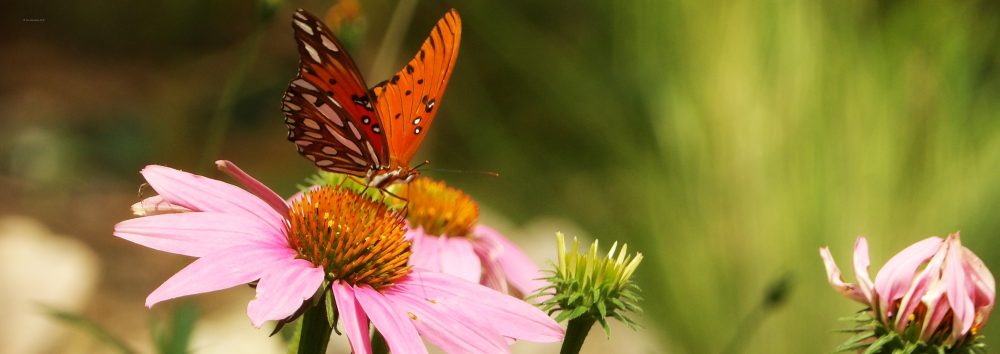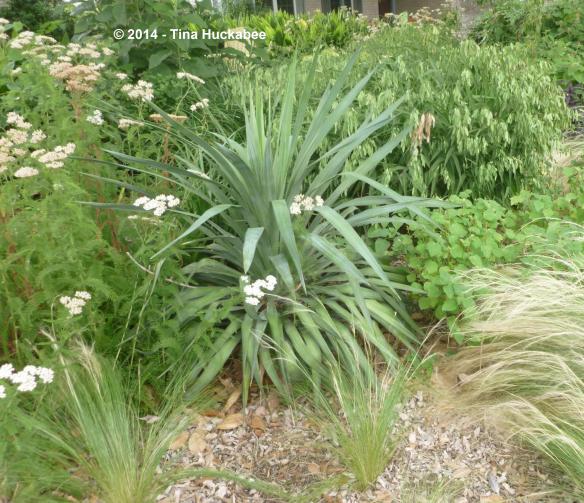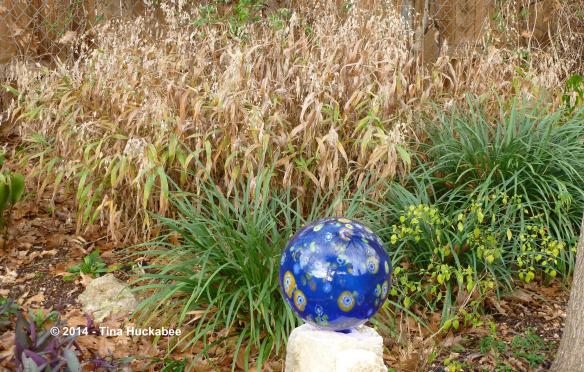I love this plant.
It’s a beautiful shade-loving grass, excellent for erosion control, prized by wildlife for cover and seeds, and a water-wise choice for gardeners.
Inland Sea Oats, Chasmanthium latifolium, is the go-to plant for so many difficult garden situations.
What’s not to love about that?
Native to a large swath of North America, this grass forms a dense cluster requiring little effort by gardeners throughout its growing season. Let’s take a look at how this valuable wildlife and landscape perennial performs throughout the year–A Seasonal Look for Inland Sea Oats.
Fresh, green stalks appear in late February or early March (in Austin, Texas) after winter dormancy and gardeners’ pruning shears. Those fresh, verdant shoots will emerge later if you live and grow further north.
I usually wait until I see the bright green sprouts of new growth from the basal clump before I cut back the previous year’s growth. However, one can prune before–it’s really a matter of aesthetics and available time. The dormant beige grass does get a bit tatty toward the latter part of winter so if that’s a problem for you whack away to the ground whenever the mood strikes!  Inland Sea Oats is attractive in winter, but it’s a good idea to plant it in companionship with evergreens,
Inland Sea Oats is attractive in winter, but it’s a good idea to plant it in companionship with evergreens,
…just because it’s nice to have some botanical interest while the Oats are dormant.
During the spring months, Inland Sea Oats grow,
…and grow. The foliage reaches two-three feet in height. Seed heads develop in the late spring and early summer, adding texture and grace to the lovely grass foliage.
Through most of summer, the foliage and seeds share the same brilliant green coloring.
Elegant and lush during the hottest time of the year, Inland Sea Oats grass is drought-tolerant, requiring little irrigation. In my gardens, soaker hoses lie along the root zone of most, though not all of my Inland Sea Oats groups and receive irrigation once or twice/month. I grow several groups that receive no irrigation at all and they endure our long, hot summers just fine. In fact, it’s a greater problem if the Oats are over-watered. If watered regularly and year round, a greater percentage of Oats seeds will germinate, thus plenty of seedlings develop. This might be desirable in a spot where immediate erosion control is desired, but probably not for most home garden situations. I remove those seedlings which grow in unwanted places in my gardens,
…but I haven’t found the Inland Sea Oats particularly troublesome to control. This grass tolerates a variety of soil types and transplants easily. Just recently, I separated and transplanted a group of three from another mature cluster into a spot which gets little direct sun.
Peeky looking for now, they’ll return with full vigor in spring. Inland Sea Oats perform best in shade or part-shade. They tend to fry when planted in full Texas sun, though in northern latitudes, the sun isn’t quite so unrelenting. It’s good to have a lovely and reliable shade plant, so use it in those spots where many plants won’t thrive–you’ll always be happy with Oats in a shady spot. Beth at Plant Postings in Wisconsin recently profiled Northern Sea Oats (another common name) for her “plant of the month” choice. It’s always interesting visiting a garden with a different climate and soil composition to review how a plant fares. C. latifolium is as gorgeous and valuable in Wisconsin as it is here in Texas. It’s a fabulous grass for many places.
As summer wanes and the days shorten, the seeds of Inland Sea Oats transform from the their summer vivid green,
…to the autumn’s toasty beige.
I think my favorite part of that transition is during the actual color change,
–some seed heads are green and some are tan. It reminds me of a lizard in mid-transformation from green to brown. I really like that.
Once the seeds have morphed to autumn beige, Inland Sea Oats is even more striking in the garden.
Until a hard freeze ushers winter dormancy, the foliage remains green, though some yellowing of individual blades of grass is normal. Also in late fall/early winter, the seeds begin dispersal, either because of critter munching or seeds dropping. The seed heads end up as little inverted “Vs”s atop the grass blades.
Inland Sea Oats has so many good qualities, besides its good looks and its water-wise and hardy nature. Highly deer resistant, (go eat something else, Bambi), it’s the host plant to several butterfly species. The stalks with the seed heads are also quite pretty in flower arrangements. I’m not one to pick flowers from my gardens for indoors, but on the rare occasions that I do, I always add some Inland Sea Oats to pop into the vase. Whether the seed heads are vivid green or tawny-tan, the stalks add beauty and interest to any flower arrangement.
So there you have it: a year in the life of the Inland Sea Oats. A grass that most gardeners (and their garden wildlife visitors) will enjoy.
Spring,
Summer,
Fall,
Winter.



































Yay, inland sea oats. They really do look great year round.
I know winter is technically just starting but have you noticed how green everything is right now? Everywhere I look I see nice rosettes on the ground and people on my street even have fresh green grass poking up. I hope this means the persimmons were wrong about it being a cold winter.
LikeLike
A great plant for all seasons! Yes, it’s still very green. My basil bit the dust and the Desert Willow foliage froze with the very first light freeze. Most of my plants are beginning their rest, but it’s not all browns and tans yet. I noticed this weekend that the Turk’s Cap stems are sprouting new leaves. Sheesh! I hope we get at least one good, hard freeze, but you never know about our winters!
LikeLike
Well we do have all of January yet.
LikeLike
And February….
LikeLike
Lovely pictures and a lovely planting idea! Do you plant these from seed or do you buy potted plants to get started? I’d really like to give these a try.
LikeLike
I recall that someone gave me my first clump of Oats years ago and the rest is history. You can plant them either way–seeds or starts. It’s a hardy plant and once you have one, you’ll have many. 🙂 I’m sure someone in your area sells Inland Sea Oats, if not you could probably order them from Wildseed Farms (out of Fredericksburg. I have a link to their website in the resources section on the menu bar.
Too bad you don’t live nearby–let me know if you’re coming to Austin anytime soon. 🙂
LikeLike
Thanks! I found seeds available at Native American Seed, but will check with the local native plant nursery first. Wildseed Farms has them, but I don’t think I need them in bulk!
LikeLike
Yeah, Inland Sea Oats is definitely not something the average gardener needs in bulk. One seed would suffice. 🙂 Good luck with your search!
LikeLike
Oh, I appreciate seeing how it looks when it’s more established! Thanks! And thank you, also, for the mention! A plant that thrives in so many different climates and settings deserves our respect and attention. It looks great in your garden in all seasons! Cheers!
LikeLike
It’s so gorgeous when it’s established–you’ll love it. And you’re most welcome–how could I not mention your wonderful profile? And I couldn’t agree more that a plant like the Inland-Northern Sea Oats are worthy of attention by gardeners in many places.
LikeLike
Much as I love this plant it can be terribly pesky seeding all over the place. I just cut mine back yesterday. It was looking pretty ratty and I thought I’d catch at least a few of the seeds before they fell among the rocks.
LikeLike
Well, that’s always the biggest complaint about Oats, isn’t it?–the seeding out everywhere. I haven’t really had that problem in my own gardens, even with Oats adjacent to pebble walkways, it’s fairly well-behaved. When I worked at Zilker Botanical, there was a natural area with small understory trees also planted with Oats that I thinned out massively when I first started that job. I worked regularly to keep that area in check the whole time I was employed there. My personal gardens are well-mulched and I wonder if that helps keep this potentially aggressive grower in bounds.
LikeLike
I’ve gotten interrupted not once but twice now, trying to comment on this post (my house is surprisingly chaotic recently but in a good way so I’m not complaining, just noting for the record!).
I’ve forgotten the original points I’d meant to make, but I do want to weigh in that the reseeding of sea oats has not been a problem for us, especially in shadier settings, and there is always the option of cutting off the seed heads before they begin to disperse. I’m a huge fan of The Oats. I think the seed heads when backlit on an autumn afternoon are as gorgeous as anything that grows here. They quite take my breath away.
Happiest New Year to you and yours!
LikeLike
Enjoy your chaos–the best kind!
I think Oats tend to be a problem in the garden with 1) very regular watering (which they don’t need), and 2) lack of mulching. I’m a mulch fan–cures the garden of all sorts of weedy ills. At Zilker Botanical, where Oats were all over, there was regular irrigation (I did complain about that–“This is a xeric garden! Stop irrigating so often!”) Also, most of the walkways were decomposed granite–beautiful, but very conducive to the germination process for every seed that landed on it. I’m like you–it just hasn’t been a problem for me and my gardens. And I also agree–those seeds in the summer, autumn, winter sun? Stunning!
A happy, peaceful and healthy 2015 to you and yours, as well!
LikeLike
Love your post! This is one of my favorites for shade, and like you, I have chile pequin and others with it. Makes such a nice strong point with only effort being yearly whack/pull errant seedlings.
LikeLike
Yup, it’s a winner! I’m glad this lovely perennial has so many fans!
LikeLike
Pingback: Foliage Day, February 2015 | My Gardener Says…
This is one of my favorite grasses (top honors go to the Japanese Forest Grass, Hakonechloa macro v. aureola, with which I’m totally smitten) even though it does seed around a bit. I need a grass that’s physically manageable, not having the ability nor access to someone with the power tools necessary to cut down or move those big miscanthus-size monsters, and sea oats admirably fills the bill. Besides, I get a kick out of the occasional visitor saying “Are you growing wheat???” 🙂
LikeLike
I love Inland Sea Oats too!! I’ve recently separated some from mature plants and plopped the new plants-with-roots in two other spots in the garden. I know some people here in Austin don’t like them, but they are simple to control,great in shade, and so pretty. I’ve never had anyone ask if I was growing wheat though.
LikeLiked by 1 person
How are people having problems? I wish mine would be a little more aggressive, or aggressive at all. Mine have remained right where I have planted them.
LikeLike
You don’t get seedlings near where you’ve planted them? I’ve never minded that they seed out. I’ve always figured a new spot for them or give them away.
LikeLike
Pingback: Autumn Natives | My Gardener Says…
When to plant? Nobody says when to plant them!!
LikeLike
Well, Mac, it really depends on where you’re planting them. I just planted some at my sister-in-law’s a couple of days ago. But I live in Central Texas and while we do have winters (our first freeze is forecasted for tonight!) we don’t have sustained cold weather. So, I plant them pretty much year-round. If I lived in Wisconsin or Illinois, I would only plant them in spring, after the last frost.
LikeLike